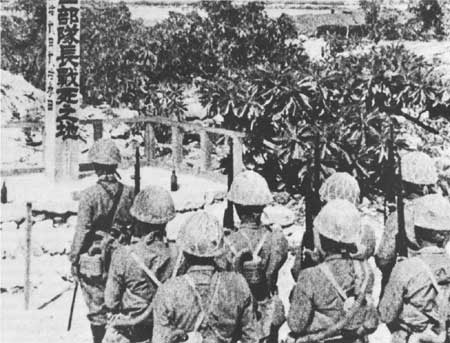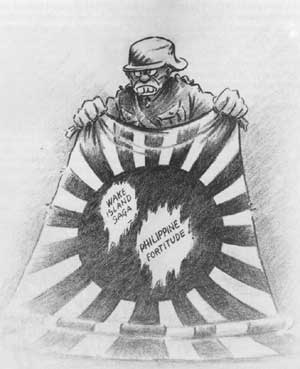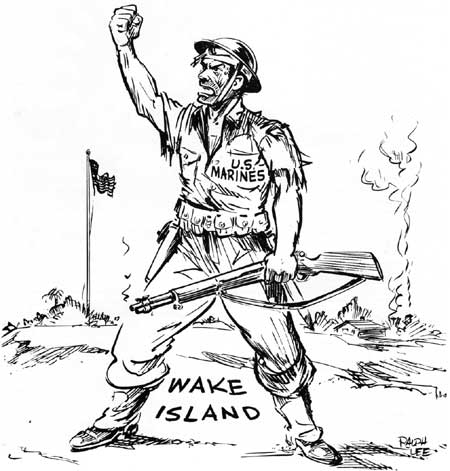
A MAGNIFICENT FIGHT: Marines in the Battle for Wake Island by Robert J. Cressman NPS DOD ‘A Difficult Thing To Do’Even as deliberations proceeded to determine the fate of the relief efforts, the men on Wake, ignorant of what was transpiring at Pearl Harbor and on the bridges of Task Force 14’s ships, fought on. Shortly before 0700 on Wake (1040, 22 December, at Pearl Harbor), the two trucks bearing Battery D’s former antiaircraft gunners, under Second Lieutenant Greeley and Captain Godbold, respectively, reached Devereux’s command post. Major Potter deployed in the new arrivals in an attempt to form a thin defensive line running across the island. The attempt was doomed because of the terrain they were being forced to defend, an area which had been partially cleared of brush as part of the airfield construction. It presented the Marines with 450 yards of ground without cover or concealment. Marine Gunner Borth established a defensive line near the battalion command post with two .30-caliber guns crewed by command post Marines and a few Marines from Battery D.At about the time Greeley and Godbold reached Devereux’s command post with Battery D’s Marines, Second Lieutenant Kessler, at Battery B, shifted his attention to a column of three destroyers off Kuku Point. Four U.S. salvos appeared to inflict heavy damage on the lead ship, so he shifted his attention to the second ship in column. After about 15 minutes, dive bombers directed bombs and strafing toward the position, the battery’s firing having called attention to its existence. Fortunately, their accuracy was poor, and Kessler’s men escaped without casualty.By that time, the situation seemed to be grim. Enemy planes were attacking every visible target. Major Potter’s final defense line was receiving increasingly heavy enemy rifle and machine gun fire. Japanese troops near the airstrip continued probing and besetting VMF-211’s encircled remnant. Wilkes had apparently fallen to the enemy. Major Devereux saw little left to be done. Still having no communication with the stubborn defenders of Wilkes and of Camp 1, Devereux had no way of knowing which of his units were still fighting.About an hour after daylight (0630), Commander Keene picked up the telephone in the contractors’ headquarters and found Commander Cunningham and Major Devereux engaged in conversation on the line. The latter reported being hard-pressed at his command post. He did not believe, he said, that the battalion could hold out much longer. Cunningham told Devereux that if he did not feel he was able to continue fighting, he should surrender. A discussion between the two men then ensued. “You know, Wilkes has fallen,” Devereux stated. Cunningham answered that he did. Devereux then stated that he did not feel he should make the decision to surrender, that Cunningham, the commander of the island, should decide. Pausing for a moment, Cunningham then told Devereux that he authorized surrender, and to take the necessary steps to carry it out. Uncertain of his ability to contact the Japanese commander, Devereux asked Cunningham to attempt to make contact with the enemy, as well. Cunningham responded: “I’ll see what I can do.” (click on image for an enlargement in a new window)Surrendering, however, would take time, and the “word” did not reach everyone right away. On Wilkes, having reorganized his men, Platt attempted at about 0800 to phone the battalion command post on Wake. He managed to reach someone at the Camp 1 motor pool, but got no farther, because the motor pool was not in communication with the command post.At about 0800, Devereux notified the units he could still reach of the surrender decision. On Peale, Kessler received orders to cease firing the 5-inch guns. At Battery E, Lewis’ men removed and smashed the firing locks. When stuffing blankets into the muzzles and firing a round did not do sufficient damage to the guns, the men rolled grenades down the barrels. Other Marines smashed equipment and chopped up electrical cables. Lewis himself destroyed the optics and electromechanical parts of the heightfinder and director by firing 20 rounds into them from his .45. Satisfied with that work of destruction, he marched his men as a unit to Devereux’s command post. At Peacock Point, First Lieutenant Barninger ordered that the 5-inch firing locks be broken and buried, the telescopes smashed, and the range-keeper destroyed. Then, running up a white flag, he ordered all hands, including the civilians who had stood faithfully with the battery, to eat as much as they could. No one knew how much the enemy would allow their captives to eat.As surrender preparations proceeded apace on one side of Wake and in the positions that Devereux had been able to reach by telephone, Poindexter’s men, meanwhile, established themselves along a line at the edge of the clearing east of Camp 1. They emplaced 10 .30-caliber machine guns to cover their entire front with interlocking fields of fire. Occasional flow-flying planes strafed their position. Japanese firing from their front, though, proved ineffective. Poindexter sent back word to Camp 1 for all “special duty personnel” to join the reserve as riflemen.When, by 0900, the enemy at the front having shown no inclination to attack his position, Poindexter ordered a counterattack toward the airstrip. Dividing his men into three 10-man squads with a non-commissioned officer in charge of each, the commander of the mobile reserve decided to launch his attack along a front which extended from the beach into the brush on the north side of the road. Poindexter’s counterattack regained the terrain between Camp 1 and the road junction west of the airstrip.Meanwhile, Devereux, accompanied by Sergeant Donald Malleck, who held aloft a white rag attached to a swab handle, set out down the north-south road along the eastern shore of Wake to contact the Japanese. As he passed Marines still in action he ordered them to cease firing.  Civilian contractors are marched off to captivity after the Japanese captured Wake. Some, deemed important by the Japanese to finish construction projects, were retained there. Civilian contractors are marched off to captivity after the Japanese captured Wake. Some, deemed important by the Japanese to finish construction projects, were retained there. Fearing a fifth column rising, the Japanese executed 98 contractors in October 1943, an atrocity for which atoll commander, RAdm Shigematsu Sakaibara, was hanged after the war. Marine Corps Historical CollectionA Special Naval Landing Force sailor soon emerged from the brush along the road and halted Devereux’s progress, covering the major and Sergeant Malleck as they took off their helmets and laid down their weapons. Unable to speak any English, the Japanese motioned them toward the hospital bunker, where Devereux found an enemy officer who spoke some English. The enemy had already captured the hospital, killing one patient and wounding another when they fired into the entrance. Soon thereafter, Commander Cunningham, who had changed into his blue uniform for the occasion arrived to arrange the details of the surrender. Devereux and Malleck, accompanied by a Japanese officer, then began the sad journey toward those Marines who still stubbornly held out ahead of them.Meanwhile, the resistance put up by Hanna and the remnant of VMF-211 had prompted the Japanese to call for more close air support. One plane overflew the embattled 3-inch gun and carried out low-level attacks that allowed the observer to fire on the position with his flexible-mount 7.7mm gun. The strafing killed two civilians, Paul Gay and Eric Bryan, and wounded Major Putnam, Second Lieutenant Hanna, and Corporal Holewinski.Having finally reached the airfield at around 0930, Devereux found that the Japanese had taken cover behind the revetments and had pinned down Hanna’s men and what remained of VMF-211’s force. The major ordered Captain Tharin, the only officer who had not been seriously wounded, to cease fire. Of the 10 men in that position, all—including the gallant Aviation Machinist’s Mate First Class Hesson—had been wounded in the last-ditch fighting.Even as elements on Wake still held out, Vice Admiral Pye was informing the CNO that Wake could not be evacuated. Japanese forces had landed, supported by cruisers and destroyers and, probably, by a covering force nearby. The “gallant defense of Wake,” Pye stated, “has been of utmost value, but hereafter Wake is a liability.” In view of the “extensive operations” then underway, the situation had forced Pye to conclude that risking one carrier task force to attack enemy forces in the vicinity of Wake was “not justifiable.” Pye had ordered the two westernmost task forces (14 and 11) to retire toward Pearl Harbor. The third (Task Force 8) he sent on an unrelated mission. On Wake, Second Lieutenant Kliewer, seeing the Japanese flags all along the beach, decided to set off the mines, blowing up the airfield, and then to fall back in the confusion generated by the explosions. Unfortunately, the rain had drowned the generator motor, which disabled the electric detonator.At 1015 Kliewer saw men carrying a white flag coming down the beach. Major Devereux was among them, with a group of what appeared to be Japanese officers. They stopped about 50 feet from Kliewer’s trench and ordered him to surrender. Kliewer’s men counseled against giving up: “Don’t surrender, lieutenant. The Marines never surrender. It’s a hoax.””It was a difficult thing to do,” Kliewer wrote later, “but we tore down our guns and turned ourselves over.”About one hour later, Devereux’s melancholy procession arrived at the lines facing the mobile reserve, which still fought stoutly. A rifleman shouted back to Poindexter that a “large group of Japs are coming down the road toward us with a white flag.” As they trudged closer, Poindexter could see no Americans in the group, and after ordering his men to hold their fire, he stepped out into the road, Springfield at the ready. Cautioning his men not to fire unless the enemy fired at him, he walked toward the group. Soon, he discerned Major Devereux amidst them, shouting to him, telling him that Wake had been surrendered.Dropping his rifle and grenades in the road, Poindexter joined Devereux, who then told him to return to his unit and order his men to drop their weapons and stand up. At that, Japanese troops, bayonets fixed, began to rush the positions they had been engaging, but were stopped by a Japanese officer who interposed himself between the two sides. As Poindexter and his men trudged toward the airstrip, he saw large numbers of enemy troops emerging from the brush and falling in along the road, confirming his suspicions that the enemy had established itself in force in the region.  In a photo copied from a Japanese pictorial history, Special Naval Landing Force troops pay homage to the memory of Lt Kinichi Uchida, whose unit lost two other officers and 29 enlisted men killed and 34 wounded at Wake Island.Department of Defense Photo (USMC) 315175 In a photo copied from a Japanese pictorial history, Special Naval Landing Force troops pay homage to the memory of Lt Kinichi Uchida, whose unit lost two other officers and 29 enlisted men killed and 34 wounded at Wake Island.Department of Defense Photo (USMC) 315175Devereux then progressed to Camp 1, which was still held by the machine gun sections of Poindexter’s group. There, a Japanese sailor climbed to the top of the water tower observation post and cut down the stars and stripes that had been flying throughout the battle. Elsewhere at Camp 1, in what could be regarded as one of the last measures of defiance to the now-victorious foe, Gunnery Sergeant John Cemeris, the Wake detachment’s machine gun maintenance sergeant, unaware of the surrender, fired briefly at a low-flying floatplane.Cemeris was not alone in his defiance. Marines on Wilkes, ignorant that their shipmates on Wake and Peale had laid down their arms, still sought to carry on the fight as best they could. Platt, sighting ships to the southwest of Wilkes, ordered Battery L to engage them. McAlister and his men hurried back to the 5-inchers, only to find the ships out of range. Enduring bombing and strafing attacks from Japanese planes, around noon the Marines at Battery L spotted small boats standing toward the channel between Wilkes and Wake, and observed several transports and warships lying about 4,000 yards out. Manning the 5-inchers, the Marines discovered one would not move and that one of the dive-bombing attacks had damaged the recoil cylinders of the other. Platt then ordered McAlister’s Marines to take up a position along the old channel and fire on the small boats. An exploding bomb killed 20-year-old Private First Class Robert L. Stevens while the men were en route to their new positions. He was the last combat casualty suffered by the Marines on Wake Island.  One of the many cartoons that mirrored Wake’s gallant battle, “Sun Spots,” shows holes marked “Wake Island Saga” and “Philippine Fortitude” in a Japanese flag. Department of Defense Photo (USMC) 529733 One of the many cartoons that mirrored Wake’s gallant battle, “Sun Spots,” shows holes marked “Wake Island Saga” and “Philippine Fortitude” in a Japanese flag. Department of Defense Photo (USMC) 529733At about 1300, Devereux reached Wilkes. Soon thereafter, a Japanese destroyer closed with the island and opened fire, apparently intent on bombarding the, but an exchange of signals quickly caused the ship to cease firing. Almost a half hour later, at a point about between the old and new channels, Devereux spotted “a few grubby, dirty men [Platt’s] who came out of the brush with their rifles ready.” They laid down their arms and surrendered, too. The men of Wake had fought well, impressing the victors with their tenacious bravery, which later proved to be inspiring, not only to the Marine Corps, but also to the nation as a whole.Of the 449 Marines (1st Defense Battalion and VMF-211 detachments) who manned Wake’s defenses, 49 were killed, 32 were wounded, and the remainder became prisoners of war. Of the 68 Navy officers and men, three were killed, five wounded, and the rest taken prisoner. The small, five-man Army communications detachment suffered no fatalities; they were all taken prisoner. Of the 1,146 civilians involved in construction programs on Wake Island, 70 were killed and 12 were wounded. Five of Wake’s defenders were executed by the Japanese on board Nitta Maru, With the exception of nearly 100 contractors who remained on Wake Island, all the rest of the civilians joined Wake’s Marines, sailors, and soldiers in prisoner of war (POW) camps. The Japanese transported the wounded military men and civilians from the island as their wounds healed and they were deemed well enough to travel. They, too, were placed in POW camps until their liberation in 1945. The Japanese lost two ships and seven planes; a score more were damaged. The casualty statistics, though irrevocably incomplete, show that at least 381 Japanese died and many more were wounded.  In a 1942 Ralph Lee cartoon a battered but still defiant Marine shakes his fist angrily at Japanese planes overhead. Department of Defense Photo (USMC) 307267 In a 1942 Ralph Lee cartoon a battered but still defiant Marine shakes his fist angrily at Japanese planes overhead. Department of Defense Photo (USMC) 307267Wake was not recaptured by American forces during the war. Air raids on Wake occurred throughout the war, the first occurring in February 1942. Raids in October 1943, however, had grave repercussions for the contractors who had been left behind. Rear Admiral Shigematsu Sakaibara, the atoll commander, who feared that the raids portended a major landing, had them all executed. He was unwilling to have his garrison threatened by such a large “fifth column.” For that offense, he was hanged as a war criminal. The U.S. recovered Wake Island after the Japanese surrender in 1945. Wake’s defense in 1941 had been one of the few bright spots during the first months of war in the Pacific. It provided Americans a stirring example of heroism. |
 Soldier of Fortune Magazine The Journal of Professional Adventurers
Soldier of Fortune Magazine The Journal of Professional Adventurers






